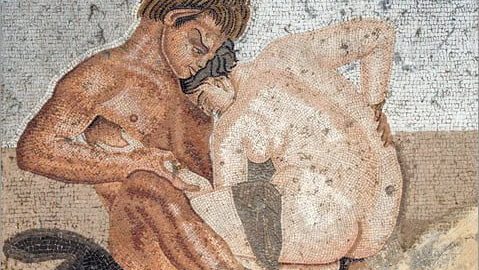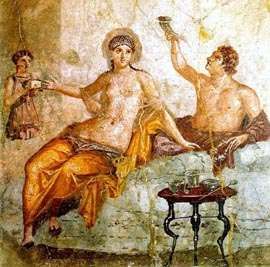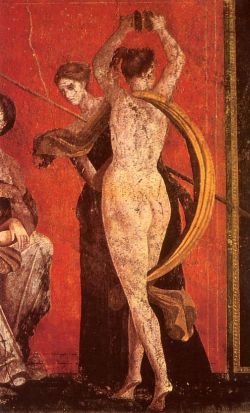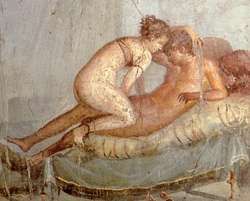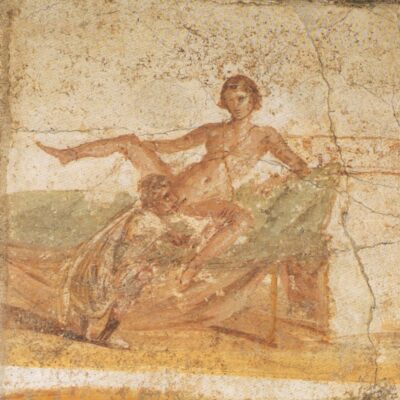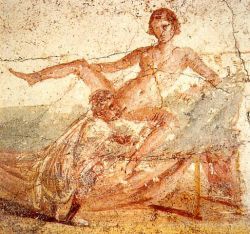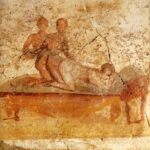Chapters
Prostitution in ancient Rome was common. Demand for such services was huge and therefore the growth of prostitution should not surprise. Rome, as a originator of law which still remains one of the pillars of our civilization, was also trying to regulate the issue of sexual services.
Source material
Roman authors did not give detailed information on the subject of prostitution. Existing sources depict various characters, which mostly means some marginal notes in the texts. It includes both historical and literary works. Many of those notes are difficult to interpret these days as they were differently understood by the scholars. The most important authors are Catullus, Ovid, Martial and Petronius.
Works concerning Roman law are also valid sources of knowledge on the subject, as some of them study prostitution extensively. So in the pandects we can find a comprehensive and detailed definition of prostitution. Equally important sources are epigrams, especially Pompeian graffiti. At the end of texts written on papyrus (mainly in the Egyptian texts) there are many statements about the economic extent of prostitution, mostly in writings from the 3rd and 2nd century BCE. Literary sources are related mainly to Rome. Further statements concern Roman prostitution during the late Republic and the Empire up to the advent of Christianity, during the reign of Constantine the Great in the late antiquity. But the matter of prostitution did not end then, even though many Christian writers were against it.
Prostitutes’ life
In ancient Rome, as in the other places in the area where existed slavery, it was possible to use the slaves according to own’s taste since they were a private property. A woman slave was beyond any laws concerning infidelity: her partner could not fault her for it, moreover, it did not matter who was her lover – her master or someone else. The laws condemning the masters for their slaves’ prostitution were so ineffective that they were being very often announced again and confirmed between the 1st and 4th century CE, like the statues claiming the intercourses between master and slave to be infidelity.
Despite that, prostitution flourished in ancient Rome and in many different places: prostitutes solicited in houses, taverns, on the street, under the arcades, in front of their doors or even on the cementers. They lured their clients in the most sophisticated ways, eg. giving away the phallus-shaped cookies.
Very early, in the 2nd century BCE, prostitutes were registered and from then on had to own a permit to practice their profession. As the citizens they were considered undignified. They represented different social classes: from the lowest, as it was in the case of the slaves’ daughters, to the highest – eg. luxurious courtesans whose services were highly expensive. However, it is worth emphasizing that, on the contrary to the other cultures, there was hardly any luxury prostitution in Rome, as the richest man could be in the intimate relationships with their slaves without any consequences. Providing sexual services was much more popular among the lower classes since in the upper classes keeping a prostitute was being found as a patronage. Only a few prostitutes attracted wealthy clients and they owed it to their erotic proficiency. The public protections of the slaves did not exist as the country gave all the rights to their masters.
The number of prostitutes was being renewed by the wave of the slaves caused by the wars or pirates, eg. 10 000 slaves were being sold every single day in Delos. In the whole Empire tens of thousands children and teenagers started to solicit every year. According to the recent findings, as it was previously suspected, the number of voluntary prostitutes was rather little. The term “voluntary” means here that the women were not forced to sell their bodies by their owners. A decree issued by Augustus (prohibiting prostitutes marrying not disgraced people) causes a doubt whether there were any voluntary prostitutes. It is widely known that there were women who occasionally rented the rooms in the brothels and offered themselves to the clients on their own account. In Rome there existed also a prostitution imposed by a father. However, the source materials describing this phenomenon appeared only during the reign of Theodosius the Great and Valentinian. Then there was passed a law stating that a father who had forced her daughter to prostitution would lose his rights (patria potestas) to her.
The causes for prostitution in ancient Rome were highly similar to those of the modern world.
The main reasons are eg. financial status, lack of education and family problems, but also laziness and greed for wealth. It was very often an easier way to earn a lot of money, in a faster and less demanding way other than manual labor, as for example the production of the fabric. On the other hand, there is the issue of the slaves’ ghastly faith. The best example is the leaden choke chain worn probably by an unruly prostitute. There was engraved an inscription on it: I am the prostitute Adulteria, apprehend me because I have fled from the city of Bulla Regia. Moreover, the sources confirm the orgies with the participation of prostitutes, during which women were beaten with sandals, singed and whipped. Also abortion was in common use, but it was extremely crude and harmful these days – there were used methods such as charms, spells, toxic lead white or sponges soaked with acetum.
Appearance
The poorest from the prostitutes, from the lowest state, were flaunting either naked or in the rash or straw belts. The rest used to wear short tunics or sleeveless robes, often green. A common denominator of Roman prostitutes were green shoes. Their identification mark was also the blond wig made from horsehair or human hair. Sometimes it was decorated with floral crown or with gold hair slides. Prostitutes were banned from wearing a long band (worn by the married women), purple lingerie and in some periods, even embroidery or golden jewels. On their feet they mostly wore sandals or pumps.
Career secrets
Customarily, also a prostitute in ancient Rome had to catch the potential clients’ attention. Those means of self-presentation were termed as artes meretriciae. They were passed among the prostitutes and they included various information such as social rules, tips concerning beauty and other general principles.
Certain things that misbecame a decent Roman woman, such as an extravagant outfit or rousing moves on the street, were necessary for a prostitute. For a long time in the studies appeared certain regulations concerning prostitutes’ dress, but today they cannot be maintained. If the prostitutes’ action were not working, she wore a simple toga with a short tunic underneath. Normally, they used to wear an average-length dress, but their work outfit was well-defined. In the brothels they appeared partly naked or with at least naked breasts. It was also highly popular to wear transparent clothes, tied or rather short dresses made from the materials imported from the East.
Prostitutes were familiar with the matter of makeup and different products for body care, which they used not only in order to hide their physical defects or lack of beauty. Most of all, what was widely popular, it was the overuse of perfume which was very often described in the ancient literature. They also paid great attention to their haircuts. The blonds were considered to be extremely desirable thus the prostitutes often brightened their hair or wore wigs. Also, depilation was widely-spread. Prostitutes without any pubic hair were valued which is known from the graffiti of Pompeii. The process of depilation did not belong to the most pleasant as the hair were spread with white arsenic or burnt lime.
Depilation took place mostly in the baths. Many brothels had their own connection to the water mains and relatively high usage of it. Cleanliness was obviously a common thing among Roman prostitutes. It seems that they used to clean themselves up between their clients’ visits, at least those in the brothels did. The prostitutes working in the streets hardly ever could have such a luxury and only after they had finished their job they went to the public thermae. In Roman culture lack of hygiene in matters of sex was considered to be heavily disgusting. Its lack was apparent during the practice of anal sex or fellatio. Also a prostitute who did not groom often lost their clients.
Those practices, which were winning prostitutes’ clients, were unacceptable for decent matrons or cohabitants. Visiting prostitutes by the young men was considered to be a common and not at all unusual thing, what is more – even healthy. However, it was condemned where the elder men did it. The elderly’s sexuality was obviously a taboo in Roman society. The old men who made use of prostitutes’ services had to reckon with being laughed at as they were expected to control their desires. The clients highly cherished oral sex which was considered to be a “royal discipline” among other sexual practices. Evidence for this theory we can find in the Pompeian graffiti. Of course, the prostitutes were very often accused of having bad breath as they were providing those kinds of services.
There were two main positions of vaginal intercourse, the first one, known as a missionary position and the second one, during which prostitute straddled her client. The course of it was mostly impersonal and rather brutal as its main aim was to satisfy the men’s wants. Also to fulfil their other needs men had to attend brothels. Cunnilingus was condemned in Roman society. A man who wanted to be provided with such a service had to go to a prostitute as it was unacceptable to do it with his own wife. In the marriage only a vaginal intercourse was permitted. It was believed that a wife should not relish sex because it was intended only for procreation. Men who eagerly satisfied women with oral sex passed for impotents. Also voyeurism was considered to be a sign of impotence because the prostitutes during the intercourse were paid by the spectators.
Other forms such as sadomasochism or coprophilia are not more widely documented.
Lupanars
Despite many incomplete and ambiguous source materials, it may be said that prostitution was current in the whole country. Prostitutes or slaves willing to provide sexual services were present especially in the cities or in places such as inns in the countryside.
Prostitutes and their clients tended to favor particular places in the city. A great source of knowledge on this subject is Ovid’s Ars amatoria where he described in detail two best places to establish a contact – pillared halls, temples, especially those devoted to female deities such as Isis, Pax, Ceres, Bona Dea or Magna Mater, but also Venus and the baths, circuses and theaters and the district Suburra, rather lower-class area. On the outskirts of the city it was possible to find prostitutes on the exit roads. Particularly famous were cemeteries along the roads.
In the provinces this matter concerned military camps and near situated brothels. It was probably explained with the fact that the legionaries could not marry. Both in front of the gates or in the camps the clients were soldiers who were traveling or temporary stationed in Rome. Meanwhile the clients in Suburra were its actual inhabitants. A Roman brothel was called a lupanar which derives from the word lupa (she-wolf). Other terms were lustrum (marsh, pool, pit, in plural lustra means brothel and promiscuity) or fornix (basement, triumphal arch). Most of all, the first two names had a rather negative tone. The lupanars were private undertakings and at bottom only in Egypt we can find examples of the regulated system about which we are not able to say anything precisely. There were a few different types of brothels and the similar: a building destined from the beginning to be a brothel; the other undertakings which except for their own products, provided also sexual services (eg. inns, taverns or different firms, especially the bakeries); single rooms which mostly opened into streets. It is hard to prove particularly first two forms because other ways to use them may be often wrongly excluded.
According to the inventory from the reign of Constantine there were 45 lupanars and in the later Curious there are listed 46. The numbers assumed for Pompeii were bloated. Today’s studies are far from those estimates and state that in the city there was only one brothel (the first type). The lupanar of Africanus or Victor are now one of the greatest archaeological examples of Roman brothels. It consisted of 10 rooms, 5 of them were downstairs, the other 5 – upstairs, but, unfortunately, the floor did not survive. The orientation was eased by the plates with the name, prize and specialization of particular prostitutes, hanging on the doors. The rooms downstairs had only 2 square meters and were smaller than those upstairs. Perhaps, they were a shelter for the more valuable prostitutes. In each room there was a bed with a bolster made of brick. There were not any accessories inside, besides the oil lamp, which lighted the rooms without windows. The rooms were closed with the wooden doors or curtains. It is thus understandable what we know from the literature, that there was rather unpleasant air inside as only the corridor provided ventilation. The prostitutes took in their clients in so-called cellae meretriciae – cramped boxes sparse over the city. Their only furnishings were the bed and the smoky lamp.
Walls in the corridors were painted with different erotic scenes at the top. It may be interpreted either as a kind of stimulation for the waiting or a catalog of provided services. Such catalogs appear also on papyrus and are known from their illustrations. Wall paintings were being ignored by the scholars as they found them immoral. They were not elaborated even once and that is why today’s information concerning this matter are rather chaotic and meagre.
The brothels often ran an intense marketing campaign to get new clients. Entries were marked in many different ways with the erotic, phallus reliefs or lamps with phallic symbols. Unfortunately, also in this case the interpretation cause great difficulties because those images were extremely immoral and did not have to concern only prostitution. For advertising purposes graffiti was painted also on the walls. Sometimes it was very clear as it was written with huge letters. It also happened that the prostitutes themselves put the writings, it was also being done by the pimps, owners or satisfied (or unsatisfied) clients.
Naturally, there were also more subtle ways of advertising. For instance, some of the prostitutes had the writings on their soles, which prints informed men where to follow them. Unquestionably, the less subtle methods were those brutal ones with which some of the pimps tempted the clients. The barkers or the client hunters sometimes even forced the clientele to this pleasure. Prostitutes were also trying to bring in clients and if the did not succeed they called them the most sophisticated names. However, the simplest way to get a client was for a prostitute to sit in front of the house naked or scantily dressed.
The best advertisement though, was a satisfied man. In Pompeii we can find a graffiti saying that certain Arpocras was very well serviced by Drauca at the price of only one denarius. A vast collection of such confessions survived on the tombs next to Porta Nocera in Pompeii.
The meaning of the word tesserae not entirely clear as it may be understood as an imperial token distributed among the people. The meaning of those spintriae cause controversies in the studies. Of course, many aspects enforce the theory that, along with circus tokens and coupon for grain and wine, there were also distributed those for the brothels. It is witnessed not only by the sexual motifs depicting the tokens but also its numbering in the range1 to 16 which agreed the prostitutes’ rates.
Clients
Prostitution was a great mean of men’s sexual initiation. It was unacceptable to have the first time with a future wife or matrons. The need of body contact led them to the prostitutes. Behavior patterns taken from the family were also not meaningless. Sons, knowing that they fathers made use of prostitutes’ services, found it not at all unusual. Thus, the head of the family was also the role model. It is not highly unlikely that the fathers at least suggested their sons contact with the prostitutes. After all the beginning of the sexual life was a sign of masculinity and adulthood.
The pressure of the male part of Roman society can not be omitted. An adolescent who, reaching certain age, did not have either opportunity or desire to have sex with a prostitutes might have been considered effeminate. Also dates were in fashion during which it was possible to fulfill somebody’s needs. What of financial matters, it seems rather obvious that the father was a sponsor of his son’s pleasure. The older men were unwelcome entering the brothels, while the younger were always connived. They were being reproached only when they threw all their fortune away.
Basically, it was normal as well Greece as In Rome that adult men enjoyed being with prostitutes of both sexes. Roman society, on the other hand, did not imagine that a woman would have any sexual contacts other than those in her marriage or cohabitation. Marriage was not supposed to give the married couple any pleasure, but primarily provide the descendants. Even showing affection was considered to be secondary and, at best, additional. Although women were seen as dissolute and lecherous they were not allowed to lead a free sexual life, either with their clients or with the other prostitutes. According to the society’s opinion, only men needed sexual fulfillment. As it was impossible in marriage or cohabitation, it was obvious for the men to look for pleasure in the brothel.
Who did not have a slave or other subordinate person who fulfilled the owner’s needs, could find a prostitute in many different places. More expensive courtesans were ordered to come to the house, as there were female dancers, instrument players and singers who were performing during holidays and often used for sexual purposes. Those not able to afford that, went to the brothels, looked for a prostitute in the streets or rented a room, where he could easily had sex. Cemetery road in front of the city gates were very famous. Prostitutes who worked there were called busturiae as they were supposed to had sex mostly with gravediggers which was thought to be particularly shameful. They were also considered the lowest class of prostitutes.
Prostitution took place mainly in the poorer districts of the city and was a common thing there. Prostitutes were not excluded from the society, on the contrary, they were a part of it. Of course, there were some restrictions, as for example those concerning marriages or those obliging prostitutes to pay special taxes. Prostitutes also participated in the religious rituals, moreover, they often played important role during public holidays and mysteries. So the clients and the prostitutes kept in close contact and they came from the same classes. The prize encouraged often visits. A man, for a relatively low prize, received various propositions and could do the things which were impossible to do with his own wife, sometimes even illegal. However, the prostitutes were not always being respected and were being raped in the brothels. From the literature we also get to know that they were beaten and abused during the intercourse. A prostitute did not have any claims concerning her job and it was unfortunately used by some men. Society with rather unpleasant manners – suffice it to say they enjoyed gladiatorial combats or hunts with the animals – did not regard prostitutes’ (both male and female) sensitivity. In art, differently than during the greek period, there are no such depictions. It is probable that prostitutes from the streets led even more miserable life than those in the brothels. In the literature clients are often described as drunk raff. It is therefore possible that two clients, in order to save money, shared one woman, what is presented in the Pompeian graffiti.
In the course of time there were established special brothels in order to fulfill the most sophisticated needs. It is possible, that next to the brothels with men and women, there were also brothels providing services with children and animals. Martial praised Domitian for the fact that he had banned buying children for prostitution. Of course it did not solve the problem as the slaves were still being used. Also in this case sources are difficult to interpret.
Among the brothels’ visitors there were plenty of slaves and freedmen who did not have any other possibility to fulfill their sexual needs. Also in this case we can find evidence in Pompeian graffiti or in literature. For instance, Cato the Elder made money letting his men slaves have sex with his women slaves. We can distinguish two types of Roman slaves, based on literature, those living in the city and those neglected, living in the countryside. It is for sure true as in the city there were more various facilities, available also for slaves, such as brothels or thermae. In the countryside there were hardly any such possibilities or they even did not exist at all.
Upper classes made use of the courtesans’ services and kept in close contact with them. Courtesans, unlike the average prostitutes, were very often supported by only one wealthy client, the same as the Greek hetaeras. Such amicae are well known from the life of many excellent Romans, including Scipio Africanus the Younger, Sulla, Verres, Pompey or Mark Antony. Courtesans were not considered to be prostitutes because of their free right to choose.
The vast majority of the clientele were soldiers. Where were soldiers, there were also prostitutes, in the wagon forts. Soldiers, who on the grounds of Augustus’ decree, could not marry (up to centurion’s position) and performed long military service did not have any other option than to go to a prostitute when it comes to sexual matters. Severe Augustus’ regulations were moderated during the reign of Hadrian and Trajan and abolished by Septimius Severus. Some of the soldiers had female slaves who surely had to provide sexual services. Homosexuality among the soldiers was unwelcome, particularly when superior abused his authority over a subordinate. From the reign of Caligula soldiers were given an extra pay for prostitutes, because from that time they were also responsible for collecting taxes from them.
And here is another reason for the development of prostitution in Rome – men could afford it. If the funds for such services were only in hands of wealthy people, only exclusive prostitutes would exist. However, they specialized in services for particular social classes. The style of nobilitas was a pattern followed by the lower classes. If the brothel was visited by a wealthy merchant or a senator, then even a proles wanted it. Of course, he could be serviced only by a prostitute of the worst sort.
Pimp
Reconstruction of the pimps’ (and other people of that kind) activity is difficult to interpret. In the early comedies, man and woman pimp were called lenones and lenae (llenocinium). They were highly bad depicted despite the fact that from the reign of Valentinian I and Theodosius I, who ultimately forbade pimp, their activity was valued. But they remained unwelcome and lived in infamy. Leno were minor pimps. It is possible that some of them managed only prostitution of their own wife, daughter or charges. But since Augustus this kind of prostitution was forbidden as an adultery.
The tavern owners, known as caupones, were also engaged in pimp on a small scale. Many of them rented rooms for the prostitutions and their clients or, besides food and drinks, offered also sexual services (provided mostly by slaves). Except from the tavern owners also hair dressers or baker men did the same thing.
Prostitutes frequently raised their own daughters or found children in order that they would work for them in the future and support them in their old age. It explains lots of male baby skeletons and only few female, found in the brothels. Prostitution of free children was considered to be one of the most wicked things in Roman society despite the fact that it was not legally forbidden. It was often explained with the impending starvation. In the case of so called not free children it was not a problem.
Professional pimps were only owners or renters of brothels. There is no information saying that street prostitution was divided into manors and managed by individual pimps. Professional pimps had a few ways to get the slaves. One of them was a slave market, other – buying a child from the parents suffering grinding poverty or raising founding and children born in the brothels. Sometimes brothel was a property of a few people or the actual owner did not want to be known as this function meant rather bad reputation in the society. Then someone else managed the brothel, mostly freedmen or a slave.
Fees
About the fees for sexual services we get to know mostly from the Pompeian graffiti. The average fee oscillated between 2 and 16 asses (the equivalent of one denarius). In the literary sources we can find an information about even lower fees, less than 1 as, which seems rather unbelievable. The lowest class of prostitutes was called Quadrantaria. This name derives from the term describing one-quarter of an as, which was a payment for such girl. Many higher fees also seem unreal, although there were many extremely well-paid courtesans. Most of the sources informing about high fees, especially those mentioned in connection with the Emperors, may be considered as a propaganda against them.
The fees recorded at Pompeii oscillated between 2 and 23 asses. Exactly half of the mentioned fees amounts to 2 asses which was the equivalent of a loaf of bread.
Sums between 2 and 23 asses are documented in Pompeii. It seems low but a prostitute could earn 2 or 3 times more than un unqualified man worker. It may be said that 2 asses was an average fee, occasionally outbid. It is also possible that the prostitutes who demanded more money had less clients. Virgins were supposed to get especially high fees.
There are very little sources concerning fees, besides Rome and Pompeii, however it is arguable that the fees in the cities during the 1st and 2nd century were the same. There are only few documents describing prostitution in the countryside. So there may be made a hypothesis stating that the local fees were a little bit higher. It may be explained with the fact that there was a smaller competition in the countryside. In the famous document from Aesernia (today Isernia) a client was drawn up an accounting which included a prostitute, obviously hired in the tavern. A prostitute costed 8 asses which is a bigger part of the bill (14 asses), including accommodation, meal and hay for a donkey.
Costs of prostitutes’ needs were estimated by the historians Duncan Jones, Bettine Eva Stumpp and others. Stumpp wrote that the minimum needed to survive was 3000 asses a year. According to her calculations a prostitute at the best of times was able to earn 6500 to 12 000 asses clear. However, it is still unclear how far those calculations reflect contemporary reality. Additionally, prostitutes became less attractive with age so they may have been rejected more often. Dependent prostitutes received less, of course, as the money was taken by the pimp or the owner. Although it may be assumed that independent prostitutes earn enough to buy themselves one or two slaves and, most of all, those slaves could work for her in her old age.
About the fees of female slaves, used for prostitution, there is very little information. Although there are very high fees given in the literature, those statements have to be understood in connection with the criticism of imperial extravagance, not having much in common with the reality. Martial assumed that an average prostitute would earn 600 denarii. It is relatively low fee for a slave, but it is rather realistic as those prostitutes were uneducated and did not have any special abilities.
Regulations
There were many attempts to regulate the matter of prostitution. A try to ban it was not taken into consideration until the late antiquity. A crucial regulation waslex Iulia et Papia, which forbade the upper classes to marry prostitutes. Its main aim was to unable prostitutes to become members of those groups. The other valid regulation concerning prostitution was lex Iulia de adulteriis, which regulated the exceptions of severe customary law. On the grounds of this document prostitutes did not underlie a penalty for adultery. This way the trade of people within the society was under control. Legally prostitutes belonged to the lowest class.Related professions, such as both male and female actors, singers, dancers or waitresses (which were equated with prostitution by its opponents) were treated the same way.
The same as in the case of other professions or other people which were liable for infamy, prostitutes also could not, or only to a limited extent, receive inheritance. Prostitutes were not secured from sexual harassing and raping (particularly by the people from upper classes) and totally unaided. It remains controversial in the studies whether an invasion to the closed room and raping a prostitute slave should be considered a rape and whether any right of possession was actually still working there.
In the Empire appeared many regulations aimed against enforced prostitution, eg. Domitian’s law agains child prostitution. Also forcing slaves to prostitution was forbidden, if they were either sold or inherited they did not have to work as prostitutes. They were thus unequivocally protected by the Roman law. However there are many examples of disregarding this law that may be found in the sources. Freed slaves could not be forced to pay their debts as prostitutes.
Since the reign of Caligula, prostitutes and pumps had to pay taxes in imitation of a Greek one which typically was an equivalent of one intercourse with a prostitute. In Egypt it was a scheduled fee. In many documents which survived there is an information about the consequent raising of this tax. Collecting those taxes was a job of different state authorities: in Rome and Carthage it was a job of the soldiers whereas in Egypt and Palmyra there were civil tax collectors.
This tax seems to have a significant meaning for the Empire which explains its constant raising (until Christianity dawned). It also indicated the validation of prostitution. As long as the tax was being raised, prostitution was allowed in Rome.
Empowerment of Christianity had influence also on prostitution: in the end of the 3rd century Pelagia unswore her previous life and began living in ascesis and passed her fortune on to the Church, but bishop Nonnus was supposed to refuse taking it.
Constantine the Great, who privileged Christianity, did not change a lot in the country’s attitude towards prostitutes. Of course, it does not mean that in the late antiquity there were not any attempts to cut it short. Somewhere around the half of the 5th century there was a try to eliminate some issues of prostitution. Florentius, according to the sources a very religious man, described as praefectus praetorio per Orientem , was trying to legislate on prostitution during the reign of Theodosius, in 428 CE. According to those, prostitutes were able to intervene to a bishop or a province governor if they wanted to finish their activity. Besides, in 439 CE Florentius took care of prostitutes’ liberation in the capital, Constantinople, and the brothels owners were exiled from the city. Also profiting form the daughters prostitution by the fathers became forbidden.
Legal prostitution
The lupanar’s ruins in Pompeii confirm that prostitution in ancient Rome was practiced on a massive scale. This profession, perceived as degrading, was still legal. The Romans were able to regulate even the matter of the “oldest profession in the world”.
Types of prostitutes
Roman prostitutes divided into two categories: meretrices (registered, credentialed and belonging to the upper classes) and prostibulae (unregistered). Among the second group the was the wide variety of different kinds of prostitutes:
- Aelicariae – prostitutes standing in front of the bakers and selling cookies in the shape of male and female reproductive organs.
- Amasiae – women devoted to Venus, today’s vamps.
- Amatrix – lesbian playing a role of a man
- Ambubiae – singing women, almost always prostitutes.
- Amica – lesbians specialising in tribadism.
- Blitidae – low-class prostitutes whose name derives from the name of a cheap drink. They allured their clients to the taverns with cheap wine.
- Busturiae – prostitutes offering their services in the cemeteries, on the tombs. They could also perform as the wailers during the funeral.
- Citharistriae – harpists, almost always prostitutes.
- Copae -tavern prostitutes, alluring clients to the restaurants and taverns.
- Cymbalistriae – dulcimer players, almost always prostitutes.
- Delicatae – prostitutes for love.
- Diobolares – two prostitutes, each worth one obol.
- Dorides – presenting themselves at the door.
- Doris – beautiful women, usually naked.
- Famosae – women from the good families who became prostitutes.
- Forariae – country prostitutes, traveling on the countryside and haunting for peasants.
- Gallinae – thieves, robbing their clients after the intercourse.
- Lupae – so-called “she-wolves” luring clients with the imitation of wolf noises.
- Meretrix – registered prostitutes.
- Mimae – women mimes, almost always prostitutes.
- Naniae – d children to the age of 6, forced to prostitution.
- Noctilucasae – active only at night.
- Nonariae – not able to appear before 9 p.m.
- Proseda – sitting in front of her room and encouraging a passerby to come.
- Prostibula -standing in front of her room and encouraging the passerby to come, unregistered prostitutes.
- Quadrantariae – the lowest class of prostitutes, who were no longer attractive.
- Scorta erratica – “saunterers”.
- Scortum – harlot.

